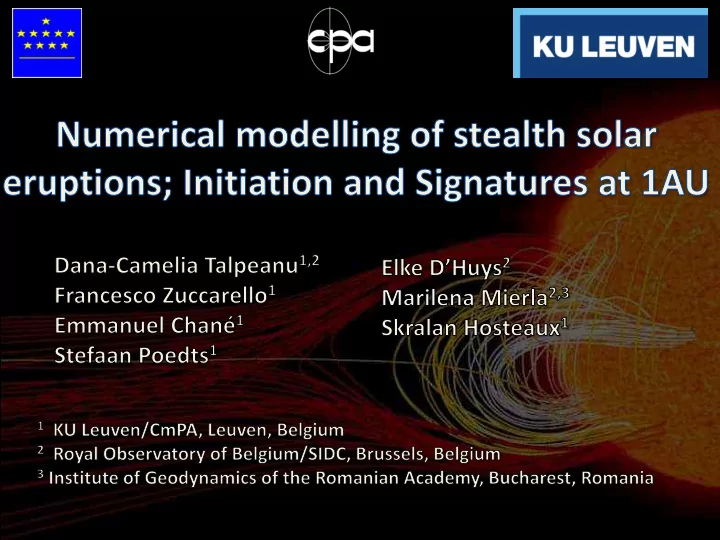

1. Coronal mass ejections • huge expulsions of magnetized plasma from the Sun into the interplanetary medium • associated with solar features (e.g. filament eruption, jet, flare, post-eruptive arcade, coronal dimming, coronal wave) Filament eruption Flare, post-eruptive arcade, Coronal wave 2 coronal dimming
2.1 Stealth CMEs • No distinct low coronal signature • D’Huys et al. (2014) - 40 stealth events • Some characteristics: slow, gradual, narrow events; preceding eruptions (Robbrecht et al. 2009) Date CME: 2 June 2008 3
2.2 Research background • 2 sympathetic events • Zuccarello et al. (2012) • Bemporad et al. (2012) Date CME: 21 September 2009 4
Bemporad et al. (2012) 5
Steps • MHD code: MPI-AMRVAC (parallelized Adaptive Mesh Refinement Versatile Advection Code) • Parameter study => range of values • Real parameters of the stealth CMEs found by D’Huys et al. (2014) • Model results <-> observationally identified events • MHD model for sympathetic stealth events 6
Code info • Domain specs: – 2.5D – spherical – axisymmetric – non-equidistant • Grid size used so far: 480x240 cells • Numerical scheme: TVDLF • CFL number: 0.5 • Limiter: minmod • Method of keeping 𝛼 ∙ 𝐶 = 0 : GLM • 3 levels of refinement 7
3.1 Results from the parametric study • transition VAC -> AMRVAC • initial conditions: dipole + triple arcade • parametric study => similar configuration • parameters varied: r – strength of the dipole and of the multipole; – the shift and width of the arcades; – shearing speed • results in accordance with those of Zuccarello and Bemporad (sympathetic event obtained) 8
Initial conditions r Global dipole field + : 𝐵 0 𝜌(𝜇+𝑡ℎ𝑗𝑔𝑢) • VAC: 𝐵 𝜒 = 𝑠 4 sin 𝜄 cos 2 2∗∆𝜄 • MPI-AMRVAC: 𝐵 0 ∆𝜄 cos 𝜌(𝜇 + 𝑡ℎ𝑗𝑔𝑢) 𝜌 sin 𝜌(𝜇 + 𝑡ℎ𝑗𝑔𝑢) 𝐶 𝑠 = 𝑠 5 sin 𝜄 2 ∗ ∆𝜄 2 ∗ ∆𝜄 𝑠 5 sin 𝜄 cos 2 𝜌(𝜇 + 𝑡ℎ𝑗𝑔𝑢) 3𝐵 0 𝐶 𝜄 = 2 ∗ ∆𝜄 9
• VAC (Zuccarello et al. 2012, Bemporad et al. 2012) • AMRVAC r r (current simulations) 10
Shearing profile 𝜌(𝑢−𝑢 0 ) 𝑤 𝜚 = 𝑤 0 (𝛽 2 − ∆𝜄 2 ) 2 sin 𝛽 sin • , + - ∆𝑢 + - 𝜌 𝛽 = 2 − 𝜄 0 − 𝜄, 𝜄 = 𝑑𝑝𝑚𝑏𝑢𝑗𝑢𝑣𝑒𝑓, Ballegooijen & Martens (1989) 𝜄 0 = −0.7 𝑠𝑏𝑒, (latitude of the southernmost polarity inversion line) 11
12
Propagation 32h after the start of to 1AU the shearing motions at the equator 24,3 ˚ N of the equator 13
48h after the start of the shearing motions at the equator 24,3 ˚ N of the equator 14
61h after the start of the shearing motions at the equator 24,3 ˚ N of the equator 15
3.2 Results from the propagation to 1 AU • stealth CME faster than the first one ⇒ reconnection at the interface • same magnetic field orientation between the 2 flux ropes; at approx. 110 solar radii (45h after the start of the shearing motions), the second flux rope completely reconnects • arrival of the CME at Earth: at approx. 45h after the eruption of the first CME • deceleration and flattening of the resulting CME/flux rope 16
3.3 Future work • Compare current results with observed signatures at 1AU • Improve current simulations • Deeper parameter study – apply the shearing on different magnetic configurations • Comparison numerical simulations ⟷ observational data (events identified by D’Huys et al. 2014) • Develop MHD model for individual stealth events 17
4. Conclusions • What? ➢ processes that cause and drive stealth CMEs ➢ difference from the typical solar eruptions ➢ a stealth CME model • How? ➢ observations and model predictions ➢ physical properties of these events (observational and model results) • Results ➢ transition from VAC to AMRVAC ➢ parameter study => configurations and sympathetic CMEs similar to those of Bemporad et al. (2012) and Zuccarello et al. (2012) ➢ shearing speed, magnetic field strength -> decisive for stealth CME appearance • lower speed: only one CME, or no eruption at all • higher speed: multiple CMEs ➢ reconnection at the interface between the 2 flux ropes, at approx. 110 Rs ➢ arrival of the CME at Earth: at approx. 45h after the eruption of the first CME ➢ deceleration and flattening of the resulting CME/flux rope 18
Thank you for your attention! 19
Recommend
More recommend